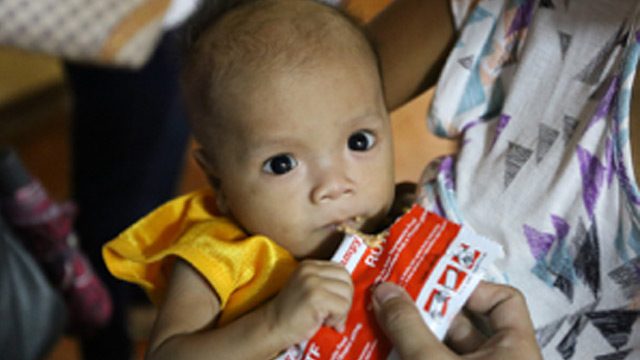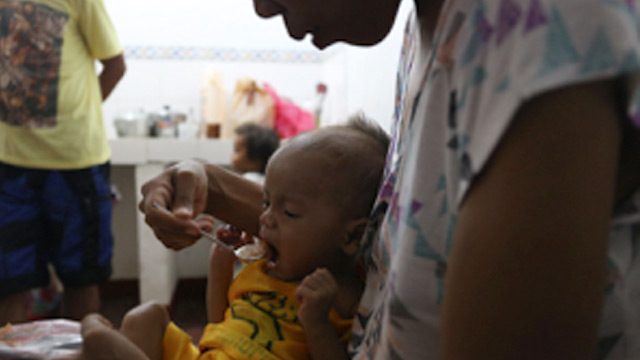SUMMARY
This is AI generated summarization, which may have errors. For context, always refer to the full article.

PALAWAN, Philippines – His name is Joemar, and he is living proof malnutrition is still victimizing a lot of disadvantaged children in Palawan.
Born in a Tagbanua indigenous community in Aborlan, a town in southern Palawan, the United Nations Children’s Fund (UNICEF) Philippines first met Joemar during its visit in August 2016.
“We wanted to see what the situation for indigenous children would be like,” said Lotta Sylwander, UNICEF Philippines Representative.
Speaking before the City Council on Monday, December 12, Sylwander said they found Joemar suffering from severe acute malnutrition (SAM), a health condition “which means the child is very close to die and has been undernourished for a very long time.”
“He was, at that point, one year old but he looked like 2 or 3 months old. And could not lift his head. He was barely responsive. He was being breastfed by his mother who also appeared like [him],” Sylwander narrated.
Her team immediately brought Joemar at the provincial hospital in the city for a treatment. But what the public hospital told her left her disappointed.
“Unfortunately the regional hospital at that point had no capacity to treat severe acute malnutrition. When I was there I was quite angry that no one could treat Joemar because I didn’t want him to be sent back to the village,” she said.
‘Big issue’
Looking closely at the government data, Sywlander found out that the MIMAROPA Region, covering the provinces of Mindoro, Marinduque, Romblon and Palawan, posted the highest rate of wasting or acute malnutrition in the country with 9.7% in 2015.
Palawan, meanwhile, got 12.4% and ranked 2nd among provinces in the region in terms of wasting rate.
Dr. Rene Gerard Galera, Jr., UNICEF Nutrition Specialist, said Palawan’s wasting rate “is actually very high” that they observed it in Africa. Wasting, he said, is a deadly form of undernutrition.
Another form of undernutrition that cripples children in MIMAROPA, especially Palawan, is the potentially irreversible stunting, Sylwander said.
“It’s not acute; the child is not going to die. But they never have enough nutrition which means they will always be shorter; they will never develop their mental capacity to the fullest extent, [and] they will, in fact, always in behind,” she explained.
For her, these two kinds of undernutrition form part of a “big issue” that should not be taken for granted, especially that they believe it “represents a violation of children’s rights to survival and development and the highest attainable standards of health.”
“I would say, probably, Palawan, including Puerto Princesa, is losing about 35% of their children at least to stunting, which means you are losing an enormous economic capacity to the country, to the city or to the island, that you can never regain,” she said.
With an estimated 4.2 million children under 5 who are stunted, the country is among the top 10 countries that contribute to stunting, also known as chronic undernutrition, according to UNICEF Philippines.

Children’s crucial days
Prevention could be done at the first 1,000 most important days of a child’s life. This is under the National Guidelines for the Management of SAM among Under-5 Children launched by UNICEF Philippines as endorsed by the Department of Health in 2015.
“So if a child is well-fed, stimulated, loved, cared and protected during those 1,000 crucial days or two first years, that child would probably be able to reach their fullest potential,” Sywlander said.
“But if a child is stunted or malnourished at his or her second birthday, or probably remained like that for the rest of their lives, it cannot be fixed afterwards.”
Meanwhile, Joemar is now recovering, said Galera.
From 3.3 kg, he grew to 6.4 kg as of December. His cheeks have filled up. He is now very active, smiles often, and can now say ‘mama.’
Joemar is being treated at home for him not to be exposed to potential communicable diseases in the hospital, the UNICEF nutrition specialist said.
While they were able to save Joemar, Sylwander said their concern is this: There are probably many Joemars out there in far-flung communities in Palawan that went undocumented and faced heaven at a very young age.
In the country, the prevalence of wasting has been consistently increasing in the last 10 years despite substantial economic growth, according to UNICEF Philippines.
“According to the National Nutrition Survey, wasting increased from 6% in 2008 to 7.9% in 2013. In 2015, the wasting prevalence was found to be 7.1% which translates into nearly 1 million wasted Filipino children under five,” the UNICEF Philippines cited.
To treat children like Joemar, the City Council, meanwhile, approved on the same day the resolution requesting the City Health Office to adopt the said SAM program in the implementation of the City’s Nutrition Program. – Rappler.com
Add a comment
How does this make you feel?
![[PODCAST] Teach Me, Senpai, E12: Travel writing and freelancing with Kara Santos](https://www.rappler.com/tachyon/2024/04/teach-me-senpai-ls-guest.jpg?resize=257%2C257&crop=455px%2C0px%2C1080px%2C1080px)

![[PODCAST] Teach Me, Senpai, E8: Illustrating and freelancing with Raxenne Maniquiz](https://www.rappler.com/tachyon/2023/12/teach-me-senpai-ls-guest.jpg?resize=257%2C257&crop=459px%2C0px%2C1080px%2C1080px)
![[PODCAST] Teach Me, Senpai, E7: Tattoos and illustrations with Wiji Lacsamana](https://www.rappler.com/tachyon/2023/11/tms-lacsamana-ls-optimized.jpg?resize=257%2C257&crop_strategy=attention)
![[PODCAST] Teach Me, Senpai, E6: Thrifting and vintage clothing with Season Pass](https://www.rappler.com/tachyon/2023/11/teach-me-senpai-ls-guest.jpg?resize=257%2C257&crop=460px%2C0px%2C1080px%2C1080px)









There are no comments yet. Add your comment to start the conversation.